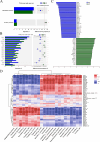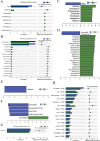Co-cultivation of Lactobacillus acidophilus and Bacillus subtilis mediates the gut-muscle axis affecting pork quality and flavor
- PMID: 40598440
- PMCID: PMC12220238
- DOI: 10.1186/s40104-025-01229-2
Co-cultivation of Lactobacillus acidophilus and Bacillus subtilis mediates the gut-muscle axis affecting pork quality and flavor
Abstract
Background: Pork quality and flavor are critical determinants of consumer preference, yet the role of gut microbiota in shaping meat characteristics remains underexplored. In this study, we investigated how a probiotic consortium (FAM: Lactobacillus acidophilus and Bacillus subtilis) modulates the gut-muscle axis to enhance pork flavor.
Results: In finishing pigs, FAM supplementation significantly increased flavor-associated nucleotides and umami-enhancing amino acids in longissimus dorsi muscle. Metagenomic analysis revealed FAM-driven enrichment of glycan-degrading Prevotella and short-chain fatty acid-producing Phascolarctobacterium, accompanied by reduced antibiotic resistance genes and virulence factors. Spearman correlation linked Prevotella copri abundance with elevated muscle amino acids, suggesting microbial-encoded CAZymes as key mediators.
Conclusions: This study provides the first evidence that probiotic-induced gut microbiota remodeling enhances pork flavor through metabolic cross-talk along the gut-muscle axis. The findings suggest a novel strategy for improving pork quality via dietary interventions targeting gut microbiota.
Keywords: Gut-muscle axis; Metagenome; Pork flavor; Pork quality; Probiotic.
© 2025. The Author(s).
Conflict of interest statement
Declarations. Ethics approval and consent to participate: The animal experiment was approved by the Animal Care and Use Committee of Zhejiang University (permit number: ZJU20230042) and all experimental procedures conformed to the institutional guidelines for animal study. All efforts were made to minimize suffering. Consent for publication: Not applicable. Competing interests: The authors declare that they have no competing interests.
Figures









Similar articles
-
Prevotella stercorea increases fat deposition in Jinhua pigs fed alfalfa grass-based diets.J Anim Sci Biotechnol. 2025 Jun 24;16(1):88. doi: 10.1186/s40104-025-01217-6. J Anim Sci Biotechnol. 2025. PMID: 40551275 Free PMC article.
-
Gut microbiota orchestrates skeletal muscle development and metabolism in germ-free and SPF pigs.Front Microbiol. 2025 Jun 16;16:1615884. doi: 10.3389/fmicb.2025.1615884. eCollection 2025. Front Microbiol. 2025. PMID: 40589574 Free PMC article.
-
Synbiotics, prebiotics and probiotics for solid organ transplant recipients.Cochrane Database Syst Rev. 2022 Sep 20;9(9):CD014804. doi: 10.1002/14651858.CD014804.pub2. Cochrane Database Syst Rev. 2022. PMID: 36126902 Free PMC article.
-
Enhanced bioactivity of honeysuckle-Cassia seeds extracts through Lactobacillus acidophilus and Bacillus subtilis co-fermentation: Impact on alcoholic liver disease and gut microbiota.Food Chem. 2025 Sep 15;486:144463. doi: 10.1016/j.foodchem.2025.144463. Epub 2025 Apr 28. Food Chem. 2025. PMID: 40339419
-
Gut Microbiota-Targeted Therapeutics for Metabolic Disorders: Mechanistic Insights into the Synergy of Probiotic-Fermented Herbal Bioactives.Int J Mol Sci. 2025 Jun 7;26(12):5486. doi: 10.3390/ijms26125486. Int J Mol Sci. 2025. PMID: 40564947 Free PMC article. Review.
References
-
- Pereira PM, Vicente AF. Meat nutritional composition and nutritive role in the human diet. Meat Sci. 2013;93(3):586–92. - PubMed
-
- Illiano P, Brambilla R, Parolini C. The mutual interplay of gut microbiota, diet and human disease. FEBS J. 2020;287(5):833–55. - PubMed
-
- Mancin L, Wu GD, Paoli A. Gut microbiota-bile acid-skeletal muscle axis. Trends Microbiol. 2023;31(3):254–69. - PubMed
LinkOut - more resources
Full Text Sources

